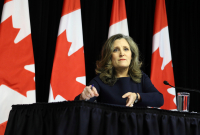Support strong Canadian climate journalism for 2025
I have no idea what this fiscal update even means given the chaos that preceded it.
Certainly, the update to the government books is worth examining to see where we’re at. But in terms of the policy proposals for the future, who knows where those will land? In a sense, the updated figures for the coming year also are equally in jeopardy, not because of the finance minister’s abrupt resignation, but because a massive 25 per cent tariff wall is looming.
As the downside scenario for next year shows, the deficit could easily be $10 billion higher. If the U.S. tariffs actually come into place on Jan 20, we’d immediately be in a full-blown recession, torpedoing tax revenues and exploding transfer costs on things like employment insurance (EI).
The fall economic statement (FES) deficit projection is larger than expected in the spring budget, with the deficit-to-GDP ratio standing at 1.6 per cent, instead of 1.3 per cent for 2024-25. Both are quite low, historically speaking for Canada. There was plenty of discussion leading into this fiscal update about “fiscal guardrails,” but thankfully no one is paying any attention to them.
The idea of guardrails is that you keep the deficit below some hard upper limit. The trouble with them is that you’re supposed to apply them in crises as well. So, if a 25 per cent tariff wall appears and drives up the deficit, you start cutting spending to stay below your target, a terrible idea in the middle of a recession. Maybe you stop EI payments or cut $10-a-day child care to not exceed your artificial target in a crisis, not a great plan.
Speaking of the upcoming tariff wall, it’s the elephant smashing about the room. There is a new commitment that federal contracts won’t go to companies from countries where our businesses don’t have access (ah-em, maybe soon in the U.S.) There is also thought in the FES about ensuring a percentage of Canadian content in federally-contracted goods and services, even if the company is from abroad.
The FES briefly promises retaliatory tariffs. The trouble is that they’ll be so large as to kick off a full-blown tariff war. Canadian workers will bear the brunt of this, particularly in areas closely linked to U.S. trade, like oil and gas, manufacturing and automotive. Companies will stop investing in new operations here and move those operations to the U.S. to try to avoid border issues. So, how does Canada deal with that?
The largest spend in this FES by a long shot is an extension of the accelerated investment incentive, making up three quarters of all new spending, $17.4 billion over five years. For context, this massive new gift to corporate Canada is worth 10 times more than the GST holiday.
This reveals government priorities in the face of a destructive tariff war with the U.S.: a massive corporate tax credit.
The program isn’t new but is winding down starting in 2024. The FES will now wind it right back up. It allows companies to reduce their corporate income taxes by more rapidly writing off capital expenditures on their taxes. There is an even faster write-off for some green investments. But what’s not highlighted is that one of the largest capital intensive industries in Canada is oil extraction, meaning this is a corporate oil-and-gas tax break.
This approach to encouraging companies to actually invest in Canada is far better than broad corporate tax cuts (which businesses would prefer), because you have to actually invest to get a credit. For broad corporate tax cuts, you can do whatever you want with the proceeds, like pay them out to investors.
The issue is how the accelerated investment incentives and similar programs in the FES for mid-sized companies or venture capital subsidies will forestall companies from fleeing to the U.S. due to the tariff wall.
Job #1 for companies is to make money, while Job #2 is to reduce their taxes. If you don’t think you’re going to turn a profit, you’re not going to invest. It doesn’t matter if the write-off period is shorter, if you don’t expect a meaningful return on that investment. Income taxes are only due if you make a profit.
Many of the classical economic answers to improving growth just don’t work in trade wars. Instead of investment incentives, we’re going to need real plans to diversify our exports away from the U.S.
This may fly in the face of what the corporate sector wants, but what’s good for corporate Canada isn’t necessarily what’s good for our economy. We’ll need governments to be actively investing in building industries that create jobs and add value to our products. And we’re going to need governments to catch workers who lose their jobs in the crossfire of tariff chaos, in things like improved EI.
The truth is these aren’t going to lead to lower deficits. They are going to lead to higher deficits. We have to remember that a deficit for the feds always means a corresponding surplus for another sector. This FES creates a $17.4-billion surplus in the corporate sector. We’re going to need much more to help workers in the chaos to come.
David Macdonald is a senior economist with the Canadian Centre for Policy Alternatives.






Comments